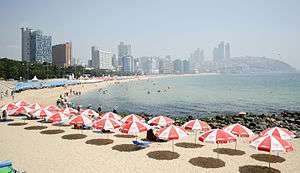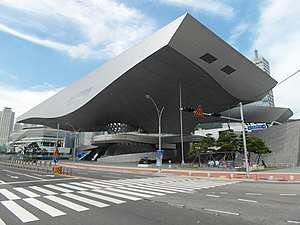Haeundae District
Haeundae District (Korean: 해운대구) is a district (gu) of Busan, South Korea.
Haeundae 해운대구 | |
|---|---|
| Korean transcription(s) | |
| • Hanja | 海雲臺區 |
| • Revised Romanization | Haeundae-gu |
| • McCune-Reischauer | Haeundae-gu |
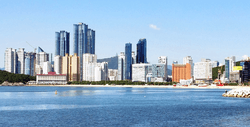 Skyline of Haeundae | |
 | |
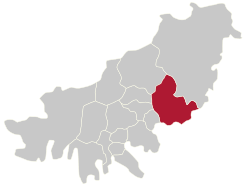 | |
| Country | South Korea |
| Region | Yeongnam |
| Provincial level | Busan |
| Administrative divisions | 18 administrative dong |
| Area | |
| • Total | 51.44 km2 (19.86 sq mi) |
| Population (2007[1]) | |
| • Total | 423,167 |
| • Density | 8,226/km2 (21,310/sq mi) |
| • Dialect | Gyeongsang |
| Website | Haeundae District Office |
Haeundae has a population of about 423,000, the most populous district of Busan with 11.6% of the city population, and covers an area of 51.44 km² (19.86 sq mi) in eastern Busan.[2] Haeundae became a division of Busan Metropolitan City in 1976 and attained the status of district in 1980. Haeundae is an affluent coastal community best known for Haeundae Beach, one of the most famous and popular beaches in South Korea, and attracts tens of thousands of tourists during summer. Haeundae is one of the wealthiest districts in South Korea, and has been subject to considerable commercial development in recent decades, including the Marine City and Centum City areas with their distinctive skyscrapers and high rise buildings.
Haeundae is linked to Busan Subway Line 2 and train stations on the Donghae Nambu railway line.
History

Haeundae takes its name from the ninth century Silla scholar and poet Choi Chi-won (literary name Haeun, or "Sea and Clouds"), who, according to a historical account, admired the view from the beach and built a pavilion nearby. A piece of Choi's calligraphy, which he engraved on a rock at Haeundae, still exists.[3]
Haeundae used to be isolated from the large communities in Busan and Busanjin. It remained undeveloped until the late 1970s and early 1980s. A small number of luxury hotels were constructed after the 1988 Seoul Olympics.[4] More hotels and other tourist facilities have been constructed on the beach-front area since the mid-1990s, and shopping malls and movie theatre complexes have been built in the 'centre' of Haeundae: an area between Haeundae Station and the beach. The area has continued to grow, apart from during the Asian financial crisis of 1997.
Haeundae has been a regular host of the annual Busan International Film Festival (BIFF). Haeundae's Dongbaek Island was the location for the 2005 APEC Conference.
Haeundae New Town (해운대 신시가지, 海雲臺 新市街地, Haeundae Sinsigaji), a major commercial and residential redevelopment project begun in 1990, is located in the Jwa-dong area. This area lies in the southern shadow of Jangsan mountain to the north, and is bounded in the south by Haeundae Station on the Dalmaji Gogae line of the Korean National Railroad. Another development project, Centum City, has been ongoing since early 2000 and is now a major feature of Busan. Its BEXCO (Busan Exhibition and Convention Center) has become a popular venue for international conventions and exhibitions. Marine City, located nearby, is constructed on land reclaimed from the sea, and has several huge, high-rise apartment blocks. Additional apartment blocks are under construction, with water resorts and related facilities, for use by the public, also planned for Marine City.
Geography
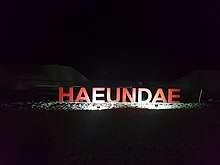
Haeundae Dalmaji Hill
Haeundae's Dalmaji Hill is touted as one of the eight attractions of Busan, and is noted for its scenic view of the moon.[5] Choe Chi-won (857-10th century), an official and poet from the late Unified Silla Dynasty (668-935), was so struck by its beauty that he decided to extend his stay there. The hill's winding trail that juxtaposes with the ocean is truly awe-inspiring. Some even say that Dalmaji Hill is Busan's answer to Montmartre.[6] The hill is also noted as one of the best places to view cherry blossoms in Busan.[7]
Haeundae Beach

Haeundae beach is regarded as one of the most famous beaches in South Korea.[8] Many events, such as religious events, BIFF movie talks, and company promotions, are held here throughout the year. The area around the beach is very developed, featuring many residential high rises and shopping centers.[9]
Film and television
Haeundae is popular in South Korean media as a setting or filming location due to being one of South Korea's most famous beaches and affluent communities. The district was the setting of the movie Haeundae', a South Korean disaster movie based on the relatively unlikely[10] scenario of an immense tsunami hitting the city of Busan. Haeundae has been featured in numerous K-Dramas, with the beach and Dongbaekseom Island being used as a filming location for Seoul Broadcasting System's 2008 drama Star's Lover. The island was the location for the scene where Lee Ma-ri, played by Choi Ji-woo confesses her love for Kim Chul Soo, played by Yoo Ji-tae; and the couple takes a walk on the beach.[11] In 2012, KBS2 broadcast a drama, Haeundae Lovers, using Busan and the district as a backdrop. Much of the story takes place in Cheongsapo, a coastal community in the district east of Haeundae Beach.
Hauendae is home to the Busan Cinema Center, the location of the annual Busan International Film Festival, which features 5 inside theaters and 1 outside theater.[12]
Food of Haeundae
Haeundae is also a popular culinary destination, boasting both traditional and foreign cuisines. Many restaurants sell dwaejigukbab (pork rice soup), one of Busan's signature dishes. The market has a wide array of seafood available, notably eel. Gumsu-Bukkuk, South Korea's most famous puffer fish stew restaurant, has its original location in Haeundae. Additionally, visitors can buy seafood from food trucks that line the beachfront.
Haeundae has a relatively large expatriate population (in Busan) and foreign cuisines are relatively popular, including Indian, Brazilian, and American. High-end cuisine can be found in many of Haeundae's hotels, as well as in Centum City and on Dalmaji Hill.
Administrative divisions
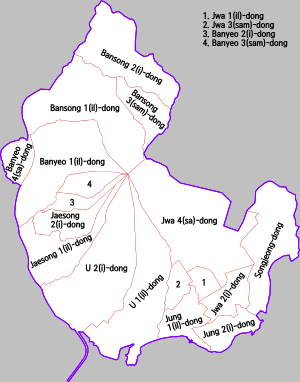
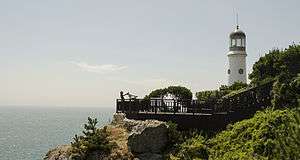
Haeundae-gu is divided into 7 legal dong, which altogether comprise 18 administrative dong, as follows:
- U-dong (2 administrative dong)
- Jung-dong (2 administrative dong)
- Jwa-dong (4 administrative dong)
- Songjeong-dong
- Banyeo-dong (4 administrative dong)
- Bansong-dong (3 administrative dong)
- Jaesong-dong (2 administrative dong)
Notable people
- Jeung Eun-ji (Singer)
- An Jae Mo (Actor)
- Kang Seung-yoon (Singer)
Sister cities

Gallery
 Dalmaji Hill
Dalmaji Hill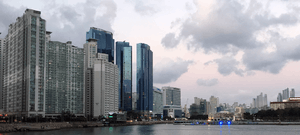
See also
- Busan
- Busan International Film Festival
- Centum City
- List of Korea-related topics
- Geography of South Korea
References
- "국제비지니스관광의 중심 "해운대"로 오세요!".
- 매력있는 세계일류도시 "해운대"로 오세요! Archived 2005-02-10 at the Wayback Machine
- "Haeundae-gu Office". Archived from the original on 2005-11-19.
- "Famous Haeundae Beach of Busan" Retrieved October 11, 2019
- "Dalmaji-gil Road (해운대 달맞이길)" Retrieved October 11, 2019
- "Dalmaji-gil Road (해운대 달맞이길)" Retrieved October 11, 2019
- "Best Places to See the Cherry Blossoms in Busan" Retrieved October 11, 2019
- "Haeundae Beach (해운대해수욕장)" Retrieved October 11, 2019
- "Top 5 Beaches to Visit in Busan" Retrieved October 11, 2019
- "Tsunamis in South Korea". Worlddata.info.
- "A Star's Lover". Korean TV Drama. Korea Tourism Organization. Archived from the original on 18 May 2015. Retrieved 30 May 2012.
- "BUSAN CINEMA CENTER". www.dureraum.org (in Korean). Retrieved 2018-03-16.
External links
- Haeundae-gu website (in English)
- Haeundae tour website (in English)
| Wikivoyage has a travel guide for Haeundae. |
| Wikimedia Commons has media related to Haeundae-gu, Busan. |
